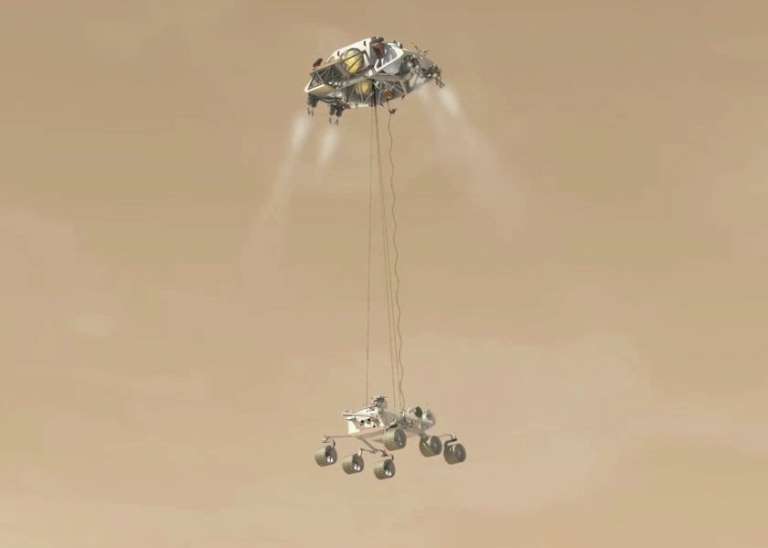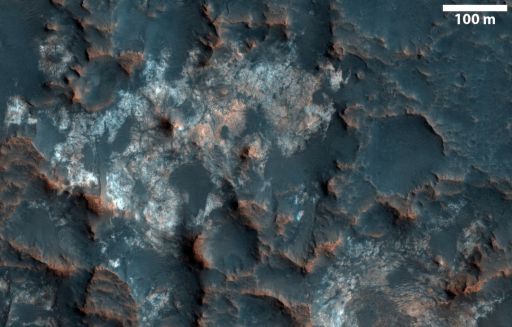Emily Lakdawalla • Nov 15, 2007
No descent images or sounds from Phoenix
A couple of days ago Malin Space Science Systems (MSSS) issued a news notice that explains some of the horse-trading that went on behind the scenes to rescue MARDI, the descent imaging camera that they are building for the Mars Science Laboratory rover, to be launched in 2009. The rescue turns out to have been a way for MSSS to salvage something from the problems with a similar instrument on the Phoenix lander (in flight for a May 2008 landing), problems that have now led to the decision to turn Phoenix MARDI off and not use it at all.
So here's the story. Last July, as Phoenix was preparing to launch, a serious problem was discovered with the MARDI instrument, which was designed to help the Phoenix team pinpoint the location of the landing site on Mars by taking 20 pictures as Phoenix descended toward the surface. I explained the problem in detail in this prelaunch news story; scroll down to the fifth paragraph, beginning "That extensive testing..." In brief, there was a late discovery of a problem with the interface between MARDI and a data-handling card on the lander that had a very small probability of causing a serious error with one of the lander's gyros during the landing. The only way to avoid this problem would be to prevent MARDI from transferring any images to the lander throughout the landing. Instead of taking 20 images on the way down, it would take only one, and keep it in an internal buffer until the critical landing procedure was over.
At least that was the solution proposed at the time of Phoenix' launch. After the launch, MSSS, Lockheed Martin, and JPL worked together to try to implement this solution. It turned out to be slightly tricky to implement. This would have been OK provided that all of the trickiness resided within the MARDI instrument and team, so that if things didn't work, the worst consequences would be that no image was acquired. Unfortunately, according to the MSSS statement, "small changes in the EDL [Entry, Descent, and Landing] sequence which controls the entire landing process were also required."

Now, mission managers are VERY nervous about making any changes at all to EDL sequences on lander missions. There is absolutely zero room for error in EDL sequences. There is also no way to test an EDL sequence from end to end -- you can do simulations of some parts of the sequence, but there just isn't a testbed for simulating all parts of a Mars landing. You get one shot and you'd better get it right. The MSSS statement goes on to say that "Although the risk to landing of either change was deemed very low, changing the timing within the EDL sequence would have necessitated additional testing, and arguments were raised that the human and time resources for this testing were in short supply. Reluctantly, the Phoenix Principal Investigator (Peter Smith) agreed, and the decision was made to leave MARDI powered off and not to take any descent images."
It's got to be incredibly frustrating to have spent the thousands of hours on designing, building, and testing an instrument for a space mission -- not to mention the much less fun thousands of hours writing and wrangling over documentation and endless meetings -- and see your instrument launch toward Mars, only to be told that it's going to be turned off. I understand why the mission team made the decision that it did, but that doesn't decrease my chagrin. Especially because MARDI was also equipped with a microphone that could have returned sounds from the descent. The Planetary Society has a big investment in the idea of a Mars Microphone -- we flew one aboard Mars Polar Lander -- so we were thrilled when we found out that Malin had built one in to MARDI. With MARDI off, the microphone won't be recording anything, which is a huge bummer.

So that's it for Phoenix MARDI. While all of this was going on, the other shoe dropped; in September NASA Headquarters responded to a request from the Mars Science Laboratory mission for more money by descoping several science instruments, including the removal of MARDI from the spacecraft entirely. The argument was made that there would be no big loss to the mission by removing MARDI, because the HiRISE camera on Mars Reconnaissance Orbiter gets such sharp images of the surface. Although the Mars community was more concerned about the loss of a different instrument, ChemCam, the removal of MARDI seemed ridiculously penny-wise and pound-foolish. As the MSSS statement explains, most of the money had already been spent on MARDI; the only expenses that remained were a few tens of thousands of dollars at MSSS to finish its construction, testing, and calibration, and a couple of hundreds of thousands at JPL to incorporate the camera into the rover's hardware and software systems. This is really a tiny amount of money. It seemed obvious from the outside that MSSS, being a decent-sized business, might be able to absorb their own part of the remaining costs internally, and indeed Malin seems to have made that offer. But the bigger chunk of money to be spent at JPL still needed to be found.
What does this have to do with Phoenix? Well, when the decision was taken to keep Phoenix MARDI turned off, that, in theory, freed up some money within the Phoenix mission, money that would have supported the Phoenix MARDI team. So JPL went to Peter Smith, hat in hand, and asked if he might be willing to let that money go to the Mars Science Laboratory MARDI team. The MSSS statement says, "With the provision that some resources be retained to enable Malin to participate as a science team member in Phoenix operations, Smith agreed to reallocate funding from Phoenix to MSL to cover the JPL costs." I don't know anything about how that negotiation took place, but it seems to me that it had to have been a pretty delicate one. Phoenix is a really tiny mission, under the Mars Scout program, with a less than $400 million budget. MSL is consuming four or maybe five times as much, more than $1.7 billion. It just seems bizarre that enormous MSL would ask tiny Phoenix for even $100k, and that Phoenix would give it up.
I wonder who all the players were in these negotiations. Was there pressure from outside? Or was it just two scientists, Malin and Smith, who, in the end, saw a solution that they could work to get more and better science from Mars? Because, in the end, the result is a good one for Mars science and for the future of Mars exploration. MARDI images will be taken as MSL lands, and it will do much, much better than HiRISE can from space. MSSS says "MSL MARDI will take hundreds of images that will start at HiRISE resolution (several 10's cm/pixel scale), and then increase to a final scale of a few mm/pixel," comprising a "near-video-like sequence." These images will be a boon to the MSL mission. But they may be more important for what they will do for future missions. The Mars community is encountering challenges finding a landing site for MSL that is scientifically fascinating that is also safe enough for its landing system (see my entry on the landing site downselection meetingfor more on that).

NASA / JPL / U. Arizona
Mawrth Vallis
Mawrth Vallis is one of the sites on Mars that has displayed evidence, seen from orbit, for the presence of minerals that may have formed in the presence of liquid water. It is one of the high-priority sites for a possible future landing by MSL. This image was taken by HiRISE on Mars Reconnaissance Orbiter on March 23, 2007. Visit the HiRISE website for the full image. It seems doubtful that MSL will actually be able to land on such terrain.What we really need to get to exciting places on Mars is a lander that can autonomously avoid hazards like rocks and steep slopes as it comes in for a landing. The data from MSL MARDI may be an important component in the development of such a system. From the MSSS statement:
Perhaps the most important function of descent imaging is terminal hazard avoidance (i.e., actively steering the lander to miss hitting rocks or steep slopes). Neither Phoenix nor MSL are employing hazard avoidance, and with respect to surface hazards, their landings are statistical "crap-shoots." Considerable effort is expended by the MEP [Mars Exploration Program at JPL], the Mars science community, and each Project to find places that reduce the risk of hitting something geological, but these efforts generally compromise the science return of the mission and remain statistical. With a demonstrably effective hazard avoidance system, a successful landing would be much more likely. But the key word is "demonstrably." Although hazard avoidance has been proposed for previous missions (including Phoenix and MSL), engineering review panels have been very conservative about allowing any flight use of such capabilities. Somehow they convince themselves that the risk of trying to actively steer the lander using input from hazard sensors introduces greater risk than not trying to avoid the hazards.
What does this have to do with MSL MARDI? Those of us who believe that active hazard avoidance is necessary to be able to land at the most important science sites feel we will need a real-world data set, acquired under actual flight conditions, to test the software central to hazard avoidance systems sufficiently to address the objections raised by past engineering review panels. MSL MARDI will take hundreds of images in a near-video-like sequence that can be used in such tests. Mars sample return and autonomously landed components of the human exploration program on both the Moon and Mars will likely need such capabilities.Well said. I'm glad it's still on the mission. But we have a long way to go until MSL launches, and I can't imagine there won't be more budget problems. It doesn't seem that they can take MARDI off again; but it didn't seem that they could have taken it off in the first place, so that shows you what I know.
Let’s Go Beyond The Horizon
Every success in space exploration is the result of the community of space enthusiasts, like you, who believe it is important. You can help usher in the next great era of space exploration with your gift today.
Donate Today

 Explore Worlds
Explore Worlds Find Life
Find Life Defend Earth
Defend Earth

